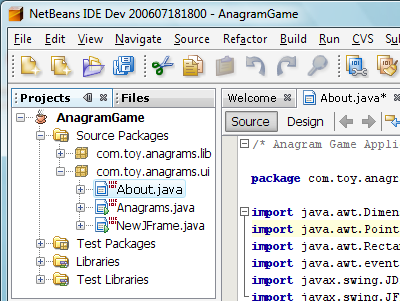NetBeans 6.0M3 vs. Eclipse 3.3M2

Last week Sun and the Eclipse Foundation both released milestone versions of their flagship Java IDE/rich client platforms. This planetary alignment provides a unique opportunity to compare the state of development of these two open source projects. We'll start with NetBeans.
NetBeans 6.0M3
NetBeans 6.0M3 was released on September 19th, 2006. Milestones are on a 5 week schedule, with 4 weeks of development and 1 week of testing. Before version 6, NetBeans used another system of "Q-builds". The NetBeans New and Noteworthy page lists a total of 3 new features for M3. Chief among those is support for Windows Vista:

The Vista look and feel design document details all the work that went into supporting Vista, including a new set of icons and pixel-accurate gradients and bevels developed by the NetBeans team. The other two features added to 6.0M3 were a stop and rerun button for the Ant view, and support for per-project launch configurations.
Eclipse 3.3M2
Eclipse 3.3M2 was released on September 22nd, 2006. Milestones are on a 6 week schedule, with Integration builds and tests every week. This release rhythm has been in place for several years (see previous articles on the Eclipse Way) and is famous for producing on-time high quality software. The Eclipse SDK New and Noteworthy page lists a total of 31 new features for M2. One of the cooler features in M2 is support for new options in the live annotation of source code:
In 3.3M2 you can select from three different coloring schemes and choose whether author and revision information should be displayed as text in addition to the coloring. The screen shot above shows the revision numbers, background colored by author, and additional information in the hover help.
Other changes include:
- a number of enhancements to the Java editor and refactoring,
- a new Clean Up preference page that allows clean up profiles to be shared within a team via regular source control,
- a built-in Java disassembler for when source is not available (I bet this will be an area of more activity in the future),
- a new editor for creating "cheat sheets" (interactive check-list style help pages),
- support for targetting non-Eclipse OSGi frameworks such as Oscar and Felix (available separately),
- 200-300% faster loading of PNG images and 30-60% faster loading of JPG images,
- a wicked new SWT graphics example program,
- and more.
Because Eclipse uses the native operating system widgets, no special changes were needed to support Windows Vista or MacOSX Leopard. Eclipse SDK version 3.3 is planned for production in late June of 2007 as part of a coordinated release of a number of Eclipse.org projects code-named "Europa".
Conclusion
If these recent milestones are any indication, then Eclipse development is far out-pacing its open source rival. This is likely because Eclipse benefits from a huge and growing ecosystem of contributors around the world, many of whom work on commercial software based on Eclipse RCP. Despite intense marketing and bundling efforts, and breaking down the barriers between the NetBeans and JDK teams, Sun has so far failed to put a dent in Eclipse's momentum. If you can't beat 'em...